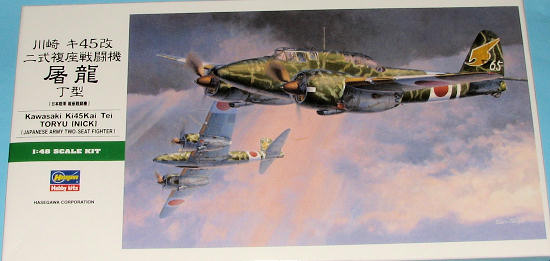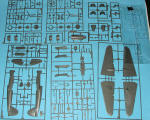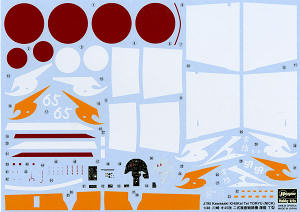
Hasegawa 1/48 Ki-45 Kai Tei Toryu
| KIT: | Hasegawa 1/48 Ki-45 Kai Tei Toryu |
| KIT #: | 19195 (Jt 95) |
| PRICE: | $53.00 MSRP |
| DECALS: | Three options |
| REVIEWER: | Scott Van Aken |
| NOTES: |

| HISTORY |
In response to the rapid emergence in Europe of twin-engine heavy fighters such as the Messerschmitt Bf 110, the army ordered development of a twin-engine, two-seat fighter in 1937, and assigned the proposal by Kawasaki Shipbuilding the designation of Ki-38. This only went as far as a mock up, but by December of that year, the army ordered a working prototype as the Ki-45, which first flew in January 1939. Results from the test flights, however, did not meet the army's expectations. The Ha-20 Otsu engine was underpowered and failure-prone, while the airframe suffered from nacelle stall.
The Ki-45 did not enter use, but the army, insistent on having a working twin-engine fighter, ordered Kawasaki to continue development. Kawasaki responded by replacing the engines with the proven Nakajima Ha-25. Flight tests were promising.
In October 1940, the army ordered continued improvements such as switching to 805 kW (1,080 hp) Mitsubishi Ha-102 engines, and using the wings from the Ki-48 light bomber. This craft, designated Ki-45 Kai, was complete in September 1941 and was officially adopted for use by the army in February 1942 as the "Type 2 two-seat fighter".
The Ki-45 was initially used as a long-range bomber escort. The 84th Independent Flight Wing used them in June 1942 in attacks on Guilin, where they encountered, but were no match for, P-40 Tomahawks flown by the Flying Tigers. In September of the same year, they met P-40s over Hanoi with similar results. It became clear that the Ki-45 could not hold its own against single-engine fighters in aerial combat.
It was subsequently deployed in several theaters in the roles of interception, ground and ship attack, and fleet defense. Its greatest strength turned out to be as an anti-bomber interceptor, as was the case of the Bf 110 in Europe. In New Guinea, the JAAF used the aircraft in an anti-ship role, as the Ki-45 was heavily armed with one 37 mm and two 20 mm cannons and could carry two 250 kg (550 lb) bombs on hard points under the wings. 1,675 Ki-45s of all versions were produced during the war.
The first production type (Ko) was armed with two 12.7 mm gun in the nose, a single 20 mm in the belly, and a movable 7.92 in the rear cabin, and this was followed with the Otsu with the lower 20 mm cannon replaced by a 37 mm tank gun, to counter B-17 bombers. While the firepower was devastating, manual reloading meant that only two rounds could be fired per minute. The next type (Hei) restored the 20 mm cannon, and this time placed an automatic 37 mm gun in the nose. A later addition was twin obliquely-firing 20 mm cannon behind the cockpit and removal of the underside 20 mm guns.
Soon after entering service, the Ki-45 was assigned to home defense, and several were dispatched against the Doolittle raid, though they did not see action. The craft's heavy armament proved to be effective against the B-29 raids which started in June 1944. However, its performance was insufficient to counter B-29s flying at 10,000 meters. Modifications such as reduction of fuel and ordnance were attempted to raise performance to little avail, and in the end aircraft were used in ramming attacks. In 1945, the forward and upward-firing guns showed some results against with the commencement of night time bombing raids, but the lack of radar was a considerable handicap. By the spring of 1945, the advent of American carrier-based fighters and Iwo Jima-based P-51s escorting B-29s over the skies of Japan brought the Ki-45's career to an end.
The next version, Kawasaki Ki-45 KAIc were developed specifically for night fighting which were supposed to be equipped with centimetrical radar in the nose, but due to production difficulties this did not occur. Having the unique Japanese Army aircraft take part in night defense of the Home Islands equipped four sentais from the autumn of 1944 to the War's end. They obtained notable successes, and one sentai obtained 150 victories and downed 8 USAAF B-29 Superfortresses in their first combat.
The Ki-45 was to be replaced in the ground attack role by the Kawasaki Ki-102, but was never wholly supplanted by the wars' end.
After World War II, three Ki-45 had fallen into communist Chinese hands. Unlike most captured Japanese aircraft that was used for training role, the 3 Ki-45s were tasked to perform combat missions, being assigned to the 1st Squadron of the Combat Flying Group in March, 1949. These three Ki-45s retired in the early 1950s.
| THE KIT |
 You
have read from previous reports of how nice the earlier incarnation of this kit
really is. This variant differs from the initial production kit by having the
bits and pieces to do the Kai Tei version of the aircraft. Nichimo fans will
instantly recognize the 5 Sentai markings on the box art and while the Nichimo
kit is still quite nice, this one does surpass it in a number of areas,
especially in cockpit and wheel well detail. Typical of Hasegawa, one is offered
both raised instrument detail and decals. Fortunately, their decals are an exact
match for the panels and fit quite well.
You
have read from previous reports of how nice the earlier incarnation of this kit
really is. This variant differs from the initial production kit by having the
bits and pieces to do the Kai Tei version of the aircraft. Nichimo fans will
instantly recognize the 5 Sentai markings on the box art and while the Nichimo
kit is still quite nice, this one does surpass it in a number of areas,
especially in cockpit and wheel well detail. Typical of Hasegawa, one is offered
both raised instrument detail and decals. Fortunately, their decals are an exact
match for the panels and fit quite well.
Some of the major changes are a different nose, two types of engine
cowling, the ventral cannon installation, and optional exhaust types. the
cockpit canopy is so designed as to be able to be posed in the open and folded
position if one desires. As this is the bomber interceptor version, twin oblique
cannon are mounted in a different upper decking piece. Two barrel lengths
are provided, this kit using the shorter ones. Of course, there are a few minor
modifications needed to properly build this version from existing kit parts, but
nothing at all difficult. Most newer Hasegawa 1/48 kits provide the option to
replace molded on formation lights with clear pieces and this one is no
exception. I also liked that Hasegawa has incorporated a very sturdy stub spar
section on which to place the wings. I found from previous kits that have this
feature that one has to be very careful when fitting the wings as it is quite a
precision fit. Though the ejector pin marks have not disappeared, I did find
them pretty well limited to landing gear legs.
Instructions are standard Hasegawa in that they are well drawn and provide color information and small detail sections when needed. As usual, there is a lot of information provided so one has to be cautious not to miss anything. Markings are for two 53 Sentai and one 5 Sentai aircraft. One is the box art plane in the very nice, but difficult to paint variegated pattern. The other two are in overall Kawasaki dark green. All three have the broad wing 'bandages', while the two 53 Sentai aircraft have these on the fuselage. The decal sheet is superbly printed and of the 'new' variety with proper whites and reds. I'm not sure just how opaque the white bands are so would caution modelers that it might be wise to paint these on the variegated camo plane. Leading edge ID stripes are also provided, and again, one may wish to paint these on.
| CONCLUSIONS |
So there you have it. Another superb Ki-45 kit from Japan's premiere aircraft modeler. It should provide an excellent opportunity to add an important type to one's collection. If one has the old Nichimo kit, then perhaps it is time for a replacement, or perhaps you should build them both!
| REFERENCES |
July 2008 Thanks to
www.dragonmodelsusa.com for the
preview kit. Get yours today at your local shop or have them order one for you. If you would like your product reviewed fairly and quickly,
please
contact
me or see other details in the
Note to
Contributors.